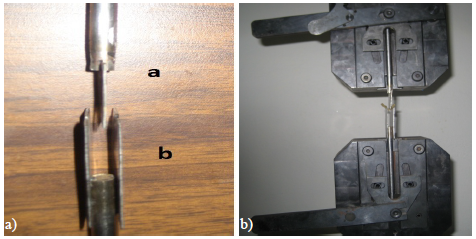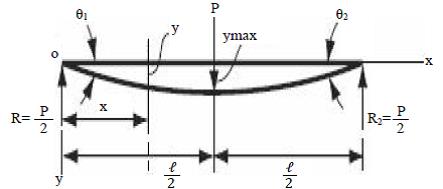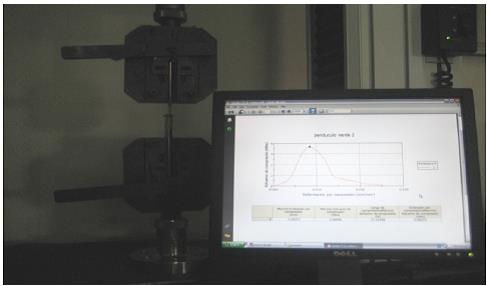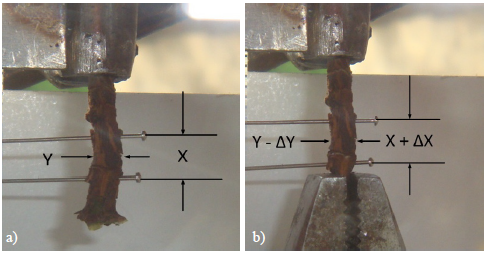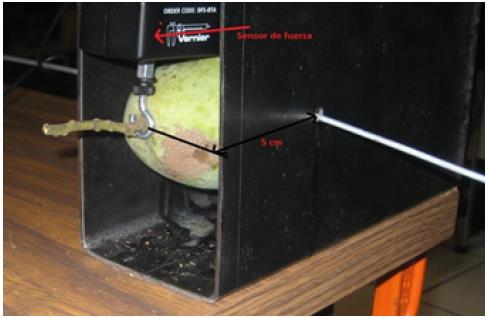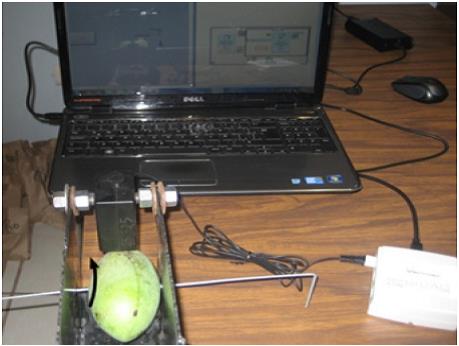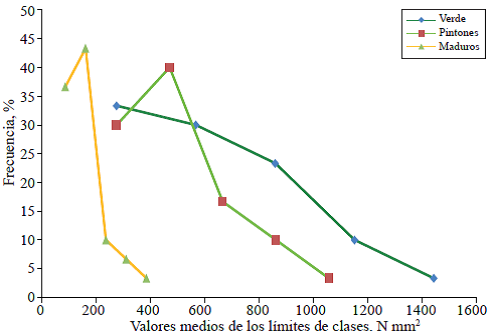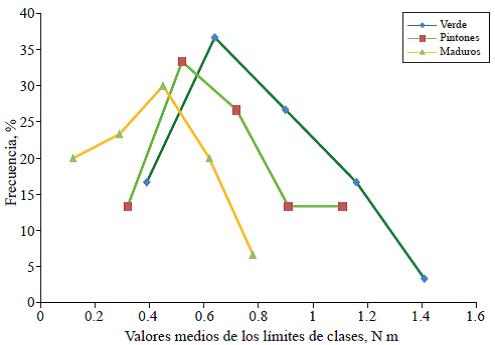Servicios Personalizados
Revista
Articulo
Indicadores
-
 Citado por SciELO
Citado por SciELO -
 Accesos
Accesos
Links relacionados
-
 Similares en
SciELO
Similares en
SciELO
Compartir
Revista mexicana de ciencias agrícolas
versión impresa ISSN 2007-0934
Rev. Mex. Cienc. Agríc vol.6 no.8 Texcoco nov./dic. 2015
Articles
Elastic properties of mango fruit-stalk system related to harvest by vibration
1Departamento de Ingeniería Mecánica Agrícola-Universidad Autónoma Chapingo. Carretera México-Texcoco, km 38.5, Texcoco, México. C. P. 56230. Tel: 5959521680. (alelopez10@hotmail.com; eugenior@correo.chapingo.mx; sobrevill2002@hotmail.com).
In Mexico, mango ranks second in terms of surface planted with 176 781 490 hectares; when mango is destined for consumption as fresh fruit, harvest is done manually, however, with increasing demand for processed products, mechanical harvesting is a viable alternative for fruit collection using inertial vibrators. This study aims to determine the elastic properties of stalk and mango fruit-stalk systems that form the physical and mechanical properties required for the analysis of the system dynamics, in order to obtain the optimal values of vibration frequency and amplitude for selective harvest of fruits. To do so, a methodology was developed and selected instruments for measurement according to details required by Mexican standards. The determinations were performed in an experimental plot of Manila mango in Idolos, Veracruz; during June 2013, obtaining average values of rigidity, flexural modulus of elasticity, Poisson's coefficient and the shear modulus of the stalk and the bending moment required for fruit detachment, in three stages of ripening. Tukey test indicates that there is 95% level of significance, significant differences between the means of the physic-mechanical properties for ripe fruits, physiological ripening and green, being an aspect that favors selective harvest of fruits when vibration is applied to branches.
Keywords: Mangifera indica L.; design parameters; selective detachment
En México, el mango ocupa el segundo lugar en cuanto a superficie sembrada con 176 781 490 hectáreas; cuando el destino del mango es para el consumo como fruta fresca, la cosecha se realiza manualmente, sin embargo; con el aumento de la demanda de productos procesados, la cosecha mecanizada es una alternativa viable para la recolección de frutos mediante la utilización de vibradores inerciales. El presente trabajo tiene como objetivo determinar las propiedades elásticas del pedicelo y el sistema fruto-pedicelo del mango, que forman parte de las propiedades físicas-mecánicas requeridas para el análisis de la dinámica del sistema, con el fin de obtener los valores óptimos de frecuencia y amplitud de las vibraciones para la cosecha selectiva de los frutos. Para ello, se elaboró una metodología y se seleccionaron los instrumentos de medición con las precisiones requeridas por las normas mexicanas. Las determinaciones se realizaron en una parcela experimental de mango de la variedad Manila en Ídolos, Veracruz; durante junio de 2013, obteniéndose los valores medios de la rigidez, el módulo de elasticidad a la flexión, el coeficiente de Poisson y el módulo cortante del pedicelo, así como el momento flector necesario para desprender el fruto, en tres estadios de maduración. La prueba de Tukey indica que existe 95% del nivel de significancia, diferencias significativas entre las medias en las propiedades físico-mecánicas para frutos maduros, con maduración fisiológica y verdes, siendo un aspecto que favorece la cosecha selectiva de frutos cuando se aplica vibraciones a las ramas.
Palabras clave: Mangifera indica L.; desprendimiento selectivo; parámetros de diseño
Introduction
The machine-tree-fruit system is a complex system composed of several subsystems, one of the most comprehensive models for the study of this system was developed by Llanes et al. (2000) and its application has been experimentally validated successfully for fruit detachment by vibration in citrus, guava and coffee.
When coupled the vibrator to an excitation point of the tree, applies to it an excitation force and as a result of this excitation at the point of application, a vibratory movement is generated causing a displacement of the point of application of excitation, that will be determined by de sign parameters and functioning of the vibrator, such as unbalanced mass, total mass of the vibrator, frequency of the oscillations and unbalanced mass eccentricity, thus magnitude and phase of mechanical impedance.
The vibrations applied to the excitation point are conveyed through tree structure to the fruit-stalk subsystem, the study of vibration transmission through tree structure is necessary to determine vibration amplitude that excite the fruit-stalk subsystem in different areas of the tree.
The tree is subjected to forced vibrations; different points of its structure oscillate at steady state with the corresponding frequency to the excitation frequency, depending on the amplitude and phase of the oscillations of these points, so will, the modal behavior that fruit assumes on the tree at this frequency. The transmission of vibrations to tree structure will be determined by amplitude and frequency in the excitation point, as the dimensional characteristics and physic-mechanical properties of the tree, such as flexural modulus of elasticity and torsion, Poisson's coefficient, bulk density, damping ratio, and moment of inertia of branches among others.
The sinusoidal excitation of frequency and amplitude will cause the oscillation of the fruit-stalk subsystem and the appearance of the bending moment in the abscission zone that must overcome the bending moment required to achieve fruit detachment. The vibration mode that fruit-stalk subsystem assumes is given by amplitude and frequency of the oscillations and the physic-mechanical properties such as the polar diameter, minimum equatorial diameter, maximum equatorial diameter, stalk diameter, stalk length, fruit mass, bulk density of the fruit and moment of inertia in the minor and major axis, stalk rigidity, elasticity modulus to bending and torsion, Poisson's coefficient and bending moment of stalk detachment.
Determine the modal behavior and vibration regimes for detachment of mango, represents a problem of high difficulty for all the variables involved. Addressing this experimental study would require a large investment of resources and time, so it is recommended to address it by mathematical modeling.
Classical mathematical models can be divided into two groups: those that consider as predominant cause fruit detachment, the action of centrifugal forces of inertia (traction), on possible abscission zones (union of the fruit-stalk; union stalk-branches or other) and those that consider it as the predominant cause fruit detachment, the action of inertial forces that cause bending in abscission zones.
The first group are associated in some of the models developed in Europe and the United States of America by Adrian and Fridley (1965); Varlamov (1972); Bobeva (1972) for studies on harvesting by vibration of fruits such as apples, plums and others, while the second group are mainly associated to models encountered in studies of harvesting by vibration of citrus in the United States of America by Cooke and Rand (1969) and in Cuba by Martínez (1977) and Castillo (1995) this model was also applied in guava by Herrera (1980) and in coffee by Martínez et al. (1989) and Gaskins (2006)).
Both Cooke and Rand (1969) model, and Martínez (1977) and Castle (1995) have two degrees of freedom and take into consideration the occurrence of deflection in abscission zones of fruits, that had not been considered in previous models and that most accurately describe the phenomenon of joint failure of fruit by stalk during harvest by vibration.
Different physical-mechanical properties of mango have been determined by several authors, Ramirez et al. (2006); Infoagro (2012), in both cases determined mass, maximum polar and equatorial diameter for some varieties, however; these properties are insufficient to apply mathematical modeling in order to know the optimal vibration modes and schemes that ensure selective harvesting of fruits.
Santos (2012) determined some physical- mechanical properties from fruit-stalk system of Ataulfo mango; however, did not take into account the stages of fruit ripening, being a prerequisite for the analysis of selectivity during mechanized harvesting by vibration.
Materials and methods
Determination of elastic properties of the stalks
Rigidity of stalk was determined building a device formed by two supports (Figure 1a) which were placed in the jaws of the mechanical testing machine Instron 3382. The support b was placed in the lower jaw and it was formed by two sheets of steel 1 mm thick and 9 mm apart in which the stalks were placed. The support was attached to the upper jaw; it was composed of a steel sheet that during its haul passes through the middle of the supporting sheets b (Figure 1b).
For the scheme of Figure 2; rigidity is calculated as:
Where: EI= rigidity of the stalk (N m2); P= load (N); l= spacing between sheets of support b (m); ymax= maximum deflection of the stalk (m).
Separation of steel sheets was 9 mm, while the load P and deflection ymax of each sample was recorded and stored in a computer with an accuracy of ±10-5 N and 10-5 mm respectively (Figure 3). To calculate rigidity of the stalk of each sample maximum load and deflection recorded in the computer from Instron were considered.
With results obtained from stalk rigidity during the experiments elasticity modulus (E) (N m-2) is determined by the expression:
Where: K= rigidity value obtained during the experiments (N m2); I= moment of 2nd order of stalk section (m4) and is calculated as:
Where: dp= mean diameter of stalk (m).
Poisson's coefficient is determined directly, by measuring the deformations caused in the stalk by a tensile force of 7.35 N. To measure deformations a digital camara Sony 10 megapixel mounted on a tripod is used and a support where the stalk is set by one end and on the other a weight of 7.35 N was placed.
Images were processed with Vision Builder AI 3.0 with a measurement accuracy of ± 0.01 pixels, while the area of stalk was defined by two needles.
The procedure consisted to take two pictures to each sample; an initial without weight (Figure 4a) where X and Y, distances were defined based on pixels in the area of the two needles and a final picture with weight, measuring the distance. X + ΔX; Y - Y (Figure 4b).
Knowing that;
It clearing ΔX and ΔY from (4) and (5) respectively have:
Where: ΔX, ΔY= deformation in axial and perpendicular direction to the stalk (mm) direction; X, Y = initial values (mm); X f, Y f= final values (mm).
Once known deformation, Poisson's coefficient is calculated as:
From the elasticity modulus and Poisson's coefficient, the shear modulus G (N m-2) is determined by the expression:
Determining the bending moment of fruit detachment
The determination of the bending moment that causes the failure of the abscission zone from the fruit-stalk system is essential in order to the application of mathematical models to calculate vibration regimes that cause fruit detachment. To determine it a device was built channel shaped with a hole at a distance of five cm from the base of the stalk and a force transducer was installed with an accuracy of ± 10-6 N, connected to the computer through an interface. The hook of the translator leaned against the base of the stalk (Figure 5).
The measurements were taken going through the fruit with a rod through the hole perpendicular to its major axis, rotating the fruit by applying a force at its free end until the stalk detaches as shown in Figure 6, recording in the computer the maximum value of force that when multiplied by the arm indicates the bending moment.
Results and discussion
The results from the measurements of the physic-mechanical properties (PFM) under study were statistically processed by the Statical Analys System (SAS) version 8.0, Statgraphics Plus version 5.1 and Microsoft Excel version 2010, obtaining for each PFM determined experimentally in the three stages of maturation mean values (x), standard error ofthe mean (e), standard deviation (o) and coefficient of variation (cv); also variational distribution curves were constructed. Additionally a Tukey test was performed to detect significant differences between mean values of each property in the three stages of ripening. Table 1, shows the results of analysis of variance for different properties under study according to stage of ripening.
Table 1 Results of the Tukey test for physical-mechanical properties from fruit-stalk system of Manila mango in the three stages of ripening.

UM= unidad de medida; MF= maduración fisiológica; a, b= medias con la misma letra no son significativamente diferentes.
Table 1 show that rigidity, elasticity modulus and shear modulus of stalk decrease from green to ripe, which influences in the reduction of natural frequencies of the systems with ripe fruits. This differentiation can cause only the fall of ripe fruit if appropriate vibration regimes are selected.
Poisson's coefficients of stalk behave different to rigidity, elasticity and shear modulus on fruits; i.e. increases from green to ripe fruit. Despite showing significant differences according to Tukey's test between stalks of ripe fruits compared to fruits with physiological ripening (half ripe) and green, its variation does not influence significantly on natural frequencies of the system, so that this variation does not affect the conditions for selective harvesting.
Regarding to the bending moment required for fruit detachment, significant differences between mean values corresponding to green fruits compared to ripe were obtained. Green fruits were far superior to ripe, which can cause a decrease in natural frequencies of vibration of the ripe fruits. This behavior is highly suitable from the standpoint of selective harvesting of mango by tree vibrations.
Table 2 shows the values of kurtosis from those physical and mechanical properties determined experimentally, observe that the mean values of rigidity, Poisson's coefficient and bending moment for fruit detachment decreases from green to ripe, since fruit stalk of ripe fruits are softer than the stalks of green fruits. These variations cause differentiation in natural frequencies of vibration in the three stages of ripening, favoring selective harvesting, however; dispersion is observed in the values of the measurements at these physical-mechanical properties, being an aspect to consider when choosing the optimum regimes for the vibration harvester machines.
Table 2 Kurtosis values of elastic properties from stalk and fruit-stalk system experimentally determined for three stages of ripening.

PFM=propiedades físico-mecánicas; EI= rigidez del pedicelo; μ= coeficiente de Poisson; Mf= momento flector de desprendimiento del fruto; x= valores medios; e= error estándar de la media; σ= desviación típica; cv= coeficiente de variación (%).
Figures 7, 8 and 9 show variational distribution curves of rigidity, Poisson's coefficient and bending moment of stalk detachment for green fruits, with physiological ripening (half ripe) and ripe, observe that the mean value locates in the vicinity of the point with higher frequency, giving greater strength to results in the comparison of means.
Conclusions
Mean values of stalk rigidity were; 608.3, 504.5 and 163.2 N mm2 for green, half ripe and ripe fruits respectively, while Poisson's coefficient, took average values of 0.54, 0.66 and 0.94 according to ripening order set out above.
Overall significant difference was observed in the properties under study regarding to green and ripe fruits. The variation with the ripening of fruits of their mean values of most of the studied properties influence the reduction of natural frequencies of the systems with ripe fruits, which positively affects the existence of favorable conditions for selective harvesting by vibration.
The mean values of bending moment for ripe fruits, with physiological ripening (half ripe) and green were 0.44, 0.66 and 0.79 N m respectively.
Literatura citada
Adrian, P. A and Fridley, R. B. 1965. Dynamics and design criteria of inertia type tree shakers. Transactions of the ASAE. 8(4): 12-14. [ Links ]
Bobeva, M. 1972. Isledovanie otiskivaneto na malinovite plodove pri vibrirane. Sielskoskostopanstva Tejnika, I, Sofia. [ Links ]
Castillo, M. A. 1995. Investigación del régimen óptimo de trabajo de los vibradores de follaje de acción vertical para el desprendimiento de naranja de Valencia en Cuba. Tesis de doctorado en ciencias técnicas, Universidad Agraria de la Habana, Cuba. [ Links ]
Cooke, J. R. and Rand R. H. 1969. Vibratory fruit harvesting: a linear theory of fruit-stem dynamic. J. Agric. Eng. 14(3):195-200. [ Links ]
Gaskins, E. B. G. 2006. Fundamentación de los modos y los regímenes de vibración del sistema fruto-pedicelo-pedúnculo del café, para la cosecha selectiva de los frutos. Tesis doctoral en ciencias técnicas. Universidad Agraria de la Habana, Cuba. 109 p. [ Links ]
Herrera, M. 1980. Estudio teórico de los regímenes de trabajo para el desprendimiento de guayaba por vibración. Tesis Profesional. Instituto Superior Politécnico José Antonio Echeverría, Habana, Cuba. [ Links ]
InfoAgro. 2012. El cultivo del mango I y II parte. URL: http://www. infoagro.com/. [ Links ]
Llanes, O. 2000. Determinación de los parámetros de diseño de vibradores inerciales de ramas para la cosecha mecanizada de cítricos. Tesis doctoral en ciencias técnicas. Universidad Agraria de la Habana, Cuba. 101 p. [ Links ]
Martínez, R. A. 1977. Estudio teórico de la dinámica del sistema fruto pedúnculo. Revista Ciencias Técnicas. Serie construcción de maquinaria. Instituto Superior Politécnico José Antonio Echeverría, Habana, Cuba. [ Links ]
Martínez, R. A.; Morales, F. J.; Gómez, A. D. y Aloysius, H. N. 1989. Determinación de parámetros de un órgano de trabajo para cosecha mecanizada de café por vibración. Rev. Cienc. Téc. Agropec. 2(3): 27-49. [ Links ]
Ramírez, V. J.; Pérez, F. J. A; Sáinz, R. R. A.; Quiñonez, F. J. A. y Ramos, B. Y. M. 2006. Cultivo, enfermedades y plagas del mango: sistemas convencional y orgánico. Gobierno de Sinaloa. México. 256 p. [ Links ]
Santos, H.A. M. 2012. Diseño y construcción de un dispositivo cosechador de mango. Tesis de maestría. Posgrado en ingeniería y uso integral del agua. Chapingo, Estado de México. 98 p. [ Links ]
Varlamov, G. P. 1972. Determinación de los regímenes de trabajo de una máquina vibradora para la recogida de frutos. Trabajos del Visjom. Moscú. Vol. 71. [ Links ]
Received: April 2015; Accepted: September 2015











 texto en
texto en 

